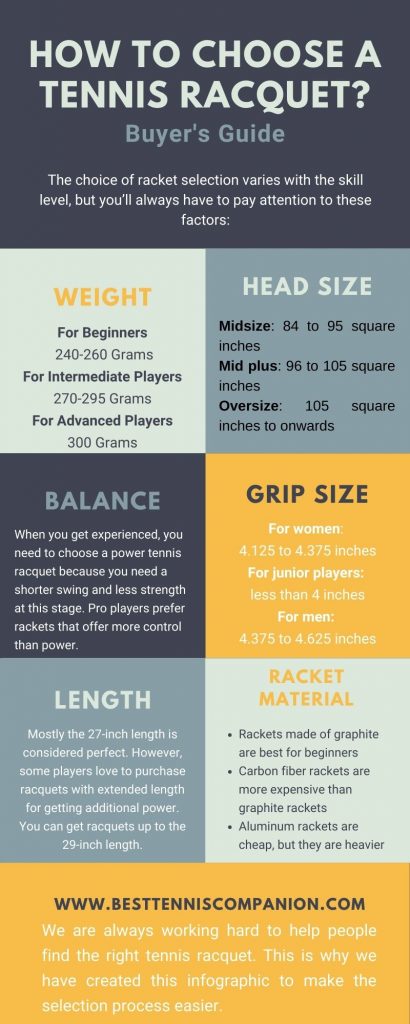Regardless of the skill level, selecting the right tennis racquet is critical. It doesn’t matter whether you’re looking for a beginner’s tennis racquet or looking for a combination of spin, control, and power; you have to choose the tennis racket wisely. You have to take different factors into account while selecting a tennis racquet. In this article, we’ll discuss how to choose a tennis racquet.
Criteria for Choosing a Tennis Racquet
Whenever you search for the best tennis racquet, you need to consider various things, such as skill level, budget, goals, age, and abilities. Let’s briefly explain all these options:
- Skill Level
It’s the first thing that you need to consider for choosing a tennis racquet. For example, if you’re a beginner, you need racquets with bigger frames and head sizes because they can help generate power. In contrast, advanced tennis racquets can help you get more control and usually come in smaller sizes.
So just decide your skill level and read our review guides about Best tennis racquets for beginners and best tennis racquets for senior players.
- Budget and Goals
If you want to play tennis for fun or to improve your health, you can try a cheap racquet. But if you want to become a professional player, the best way is to purchase high-quality racquets.
If you have a tight budget, don’t worry because here is our guide about best budget tennis rackets.
- Age and Abilities
People often ignore this factor but considering your athletic abilities can help you choose the right tennis racquet. For example, if you’re young, you can choose a large and heavy tennis racquet. But older players need to choose lightweight tennis racquets.
Factors to Consider When Buying a Tennis Racquet
The choice of racket selection varies with the skill level, but you’ll always have to pay attention to these factors:
1- Weight
Tennis rackets vary in weight. The starting weight is 240 grams, and it goes up to 340 grams. Some extreme rackets are heavier than that. Light rackets are mostly between 240 to 260 grams. They provide excellent control, but they can’t generate much power.
Moreover, they are good choices for maneuverability. Lightweight rackets are ideal for junior players. These rackets are also helpful for players who want easier to move racket in the court.
Furthermore, mid-weight rackets are mostly between 270-290 grams. They’re suitable for power and control. Mid-weight rackets are best for club players because they want to improve their game.
Rackets above 300 grams are considered heavy weight rackets. They’re good at generating power behind the ball and also help in maintaining control during a faster swing. They’re suitable for intermediate and advanced players.
2 – Head Size
It’s the second most crucial factor. Head size is the indicator of the actual hitting area. Head size can be divided into three categories, such as:
- Midsize: 84 to 95 square inches
- Mid plus: 96 to 105 square inches
- Oversize: 105 square inches to onwards
Now the question is, which head size is the best? It depends on your skill level. For example, oversize head racquets are suitable for beginners because they need more sweet spot for hitting the ball. Moreover, it can help generate power.
On the other hand, when the game level is improved, players tend to look for shorter head rackets because they want more accuracy and control over the shots. Experienced players can generate power in the shots. So, they go for either midsize or mid plus size tennis rackets.
You can also read our guide about Tennis Racquet Size Selection.
3 – Balance
As mentioned at the start, each factor helps in game improvement, so you can’t ignore any one of these. When you get experienced, you need to choose a power tennis racquet because you need a shorter swing and less strength at this stage.
When your game improves, you can generate more swing, but it can’t help generate power, so you need a power racket for generating power in the shots. Pro players prefer rackets that offer more control than power. They like those rackets that have weight distributed evenly throughout the frame.
These types of rackets have a heavier handle so that they can absorb more shock and vibrations. Moreover, head light tennis racquets can generate spin and maneuverability. Experienced players love these rackets.
4 – Grip Size
Grip size is the most important consideration and often the neglected one. Grip size can help improve your performance. On the other hand, a wrong grip size can cause injuries. Ensure that the racket fits well in hand.
You can calculate your grip size by measuring the distance from your middle finger’s top to the central line in your palm. This distance will be measured in inches. Grip size shouldn’t be too small or too large.
Everyone has a different hand size, so before buying the tennis racket, check your grip size. We would recommend going for a small grip size if you’re not finding the right one for you. You can add an overgrip tape.
For most women, the grip sizes are between 4.125 to 4.375 inches. For junior players, the grip size is usually less than 4 inches. Moreover, for most men, the grip sizes are between 4.375 to 4.625 inches.
5 – Tennis Racquet Length
Mostly the 27-inch length is considered perfect. However, some players love to purchase racquets with extended length for getting additional power. You can get racquets up to the 29-inch length.
Extended length racquets leverage more swing and can help generate more power in the shots. Meanwhile, long racquets are difficult to aim, and they aren’t easy to maneuver. So, the ideal racquet length for all skill level players is 27-inch. However, juniors and kids can go with 19-25-inch racquets.
6 – Tennis Racquet Material
Rackets made of graphite are best for beginners because they’re lightweight and powerful. Don’t forget, graphite tennis rackets are expensive. Moreover, beginners can choose racquets made of aluminum and titanium because they provide comfort when hitting the ball.
You can ignore racket material if it’s in your budget and feels comfortable in your hand. Aluminum rackets are cheap, but they are heavier, so they are not suitable for beginners. Carbon fiber rackets are more expensive than graphite rackets.
| Skill Level | Weight | Head size | Length |
| Beginner Tennis Players | 240-260 Grams | Above 105 sq. in. | 27-inch |
| Intermediate Tennis Players | 270-295 Grams | 96 to 105 sq. in. | 27-inch |
| Advanced Tennis Players | 300 or 300+ Grams | 84 to 95 sq. in. | 27-inch |

Frequently Asked Questions
What’s the difference between women’s and men’s tennis rackets?
The main difference between men and women is women can’t generate much power and spin like men. But they generally have more control than men. Therefore, when searching for the best tennis racket for women, ensure that you prefer power and spin. While in the case of men’s tennis rackets, the focus should be on control. But as mentioned earlier, you need to consider all the factors mentioned above when choosing the tennis racket.
If you’re searching for women’s tennis racket, read our review guide about Tennis Racket for Women. Moreover, this guide about the Best Tennis Racquets can help you choose the best racket.
What racquet head size pro players use?
Before we answer this question, it’s crucial to understand that racquet head sizes range between 85-125 square inches. The mid-size (85-90), mid plus (95-100), over-size (101-110), and finally, the super-oversize is (111-125). People can choose head size according to their level of play and what they want to get from a tennis racquet. Most pro players use racquets with head sizes ranging in mid-size or mid plus because it helps them get more control over the shots.
Conclusion
Our tennis racquet selector guide will help everyone to choose the right tennis racquet. The purpose of this detailed article to help people find the perfect racket that can help improve their game.
So, you need to consider all these factors when buying a tennis racquet. This guide is for all skill level players. So, everyone will find it helpful.






